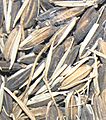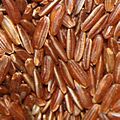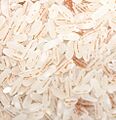Whole grain facts for kids
A whole grain is a special kind of grain that has all its natural parts. Think of it like a tiny seed! It includes the endosperm (the biggest part, full of energy), the germ (the part that can sprout into a new plant, packed with good stuff), and the bran (the outer layer, full of dietary fiber).
When you eat whole grains, you get all these healthy parts. This is different from refined grains, where the bran and germ are removed. Eating whole grains is a great way to have a healthy diet. They give your body carbohydrates for energy, lots of different nutrients, and important fiber. Fiber helps your tummy work well!
Contents
Types of Whole Grains
There are many different kinds of whole grains. They can be split into two main groups: cereals and pseudocereals.
Cereal Grains
These are the most common types of grains we eat.
- Wheat: This includes different kinds like spelt, emmer, farro, einkorn, Kamut, and durum.
- Rice: You can find whole grain rice in many colors, like black, brown, and red rice.
- Barley: Look for hulled or dehulled barley, but not "pearl" barley, as that usually has the bran removed.
- Maize or Corn: Yes, corn is a whole grain!
- Rye
- Oats: This includes oats without their husks.
Smaller Cereal Grains
These grains might not be as well-known but are still very healthy.
- Millets
- Sorghum
- Teff
- Triticale
- Canary grass
- Job's tears
- Fonio, black fonio, Asian millet
- Wild rice
Pseudocereals
These plants are not true cereals, but their seeds are used in similar ways to grains.
How to Find Whole Grains
It can sometimes be tricky to know if a food is truly whole grain. Here are some tips:
- Check the ingredients list: In places like the United States and Canada, the first ingredient should say "whole wheat flour" or "whole grain [name of grain]". If it just says "wheat flour," it might not be whole grain.
- Don't trust the color: Some breads are made to look brown with things like molasses or caramel color. This doesn't mean they are whole grain!
- Look for all parts: A true whole grain product should have all the parts of the grain (bran, germ, and endosperm) in the same amounts as they are found in the original grain.
- Fiber isn't the only sign: While whole grains have fiber, some products add extra fiber from other sources. So, high fiber doesn't always mean it's a whole grain.
What to Look for on Labels
In the U.S., some names clearly mean a product is whole grain:
- "Whole wheat bread"
- "Whole millet"
- "Whole wheat buns"
- "Whole wheat macaroni"
- "Whole wheat spaghetti"
- "Whole wheat vermicelli"
- "Whole wheat flour"
- "Graham flour"
- "Bulgur (cracked wheat)"
In Canada, if wheat is milled into flour, all parts of the kernel must be used in the same amounts as the original kernel for it to be called "whole grain." A small part (up to 5%) can be removed to help the flour last longer, but if too much is taken out, it's no longer considered whole grain.
In the UK, the special word is wholemeal instead of wholegrain. There are also guidelines to help companies label products correctly.
Images for kids
-
African rice in its inedible husk (seed rice, will sprout)
-
The same rice, dehusked (whole grain rice, color varies by variety)
-
The same rice, with almost all bran and germ removed to make white rice
See also
 In Spanish: Grano integral para niños
In Spanish: Grano integral para niños




